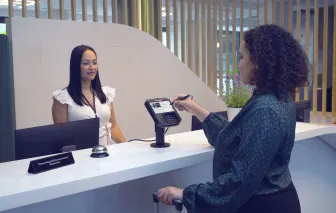Android POS is transforming payments in Australia, New Zealand, and the Pacific Islands

The payments landscape in the Pacific region is in constant motion, adapting to the ever-changing technology, infrastructure, and consumer preferences. This thriving market comprises 40 million people, with Australia accounting for 26 million, New Zealand for 5 million, and the remaining 10 million spreading across various Pacific islands, such as Fiji and Papua New Guinea.
The trend among consumers in this region is shifting towards digital payments. With a rising adoption rate, transactions are expected to reach USD 211 billion by 2027. Moreover, the pandemic also had a significant impact on consumer behavior, driving the adoption of non-cash transactions due to various factors.
- Consumers turned to e-commerce, mobile wallets, and contactless payments for convenience, health, and safety.
- As businesses digitized, there's demand for digital payments and solutions.
- The rise of fintech, particularly PayTech, contributed to the region's digital payment expansion.
Different ways consumers are paying today
More and more consumers in Australia opt for non-cash payment methods, with three main trends standing out. First, payment cards represented 65% of all transactions in 2022, according to a GlobalData study. And the debit card dominates the market due to its low transaction fees and ease of use. It is also widely used for in-store transactions through Electronic Funds Transfer Point of Sale (EFTPOS) terminals available nationwide. Australians now make an average of 650 electronic payments per year, compared to just 300 card transactions per person a decade ago. Plus, benefits such as reward points, discounts, and cashback offers further incentivize consumers to choose this as their primary transaction method.
The country is also one of the world's most advanced contactless card markets, with major banks and merchants embracing the technology, making it an even more attractive option for consumers. Contactless payments are expected to reach 65.8 million people as acceptance infrastructure grows by 2026.
Next, QR code-based payment solutions are also gaining traction. For a start, EFTPOS, Australia's national debit card scheme, launched its QR code payment solution, eQR, in November 2021 in partnership with banks and retailers. The company planned to roll out a QR Code payment network covering online, mobile, and high street transactions. Again, its popularity ties back to touch-free convenience and debit card transactions that Australians are becoming familiar with.
On top of that, the Reserve Bank of Australia (RBA) and its Payments System Board have also introduced New Payments Platform (NPP), a real-time payment and fund transfer service that operates 24/7/365, allowing QR code-based instant payment solutions and third-party payment initiation services which will likely expand its adoption in the market.
Lastly, Australia is the fifth largest country to embrace Buy Now Pay Later (BNPL), with established third-party providers and services offered by Australian central banks.
The New Zealand market is very much similar to Australia. It's a highly banked society with monetary authorities pushing for financial inclusion and debit card use. The country has regulated merchant service fees and capped interchange fees. Contactless debit card interchange fees remain at 0.2%, while swiped and inserted debit cards will have no fees making it an attractive payment instrument.
Like in Australia, its contactless payment adoption is driven by transportation, with the Waka Kotahi NZ Transport Agency launching its contactless fare payment system at the end of 2022. Meanwhile, mobile POS terminals, BNPL services, and alternative payment solutions such as digital wallets and mobile payment apps are gaining prominence with New Zealander consumers.
For the Pacific Islands, the emergence of FinTech and nonbank financial services presents new opportunities for financial inclusion and economic growth. Moreover, as evident in other countries, digital payments provide base-level digital finance, which is vital for consumers in the Pacific Islands to enter the formal financial ecosystem.
These payment trends will continue to evolve not only for the Pacific region but for global consumers. Advancements in technology, evolving consumer preferences for ease and digitalization, and regulatory developments fostering competition and innovation all contribute to the complexity of in-store payments. And it all starts at the point of sale.
Android-powered smart POS, the game changer
Modern payments have become more sophisticated and invisible. It is faster, seamless, and embedded within the consumer buying journey. PayTech, or payment technology, is predicted to reshape the consumer payment experience and has a projected value of over $2.17 trillion.
Consumers are already leaning toward more convenient and efficient alternative payment methods like digital wallets, QR codes, or Buy Now Pay Later. Merchants inevitably must accept these methods to meet demand or risk losing customers and their business.
In recent years, in-store payments have shifted to an Android-based payment system at the Point of Sale (POS) due to its versatility, security, and open-source nature. And not to mention that the robust operating system enables millions to perform various tasks daily on their smartphones. However, the main differentiator is that the Android based smart POS is equipped with the highest level of security to process payments and protect customer data.
Why businesses should switch to an Android smart POS:
- Connectivity: Wi-Fi and data connections ensure consistent connection and optimum battery capacity for total operating hours.
- Portability: smart POS devices are compact, durable, and sometimes pocket-sized for on-the-go payments like taxis and delivery services.
- Versatility: Android OS POS allows seamless implementation of payments and business software and peripheral integration, such as NFC for contactless payments, QR codes, and barcode scanning.
- Scalability: Android OS versatility enables tailoring payment solutions to meet specific business needs. Merchants and service providers can offer emerging, value-added, payment-linked services for optimal customer experience.
- Security: Android OS has significantly improved security in recent years. While it is an open development platform, Android-based payment systems must comply with PCI-PTS requirements and security restrictions.
Ingenico's AXIUM range of Android smart POS devices is the foundation of our payment and commerce solutions, enabling our customers to streamline operations, increase efficiency, and drive growth. Customers can bundle Ingenico's flexible, scalable services tailored to their needs and quickly adapt as their business evolves.
Smart POS terminal estate: Access over ownership for acquirers
The POS terminal is transforming with new payment methods, presenting opportunities and challenges for banks and acquirers providing the POS terminal service to their customers. They must adapt to rising merchant expectations, new security methods, and competition from fintech. Banks, in particular, are transitioning to fully digital infrastructures and seeking partnerships to stay competitive.
In a fast-moving world, the in-store payment system must be user-friendly, adaptable, and able to handle any transaction on any device. At the same time, acquirers and merchants face high hardware upgrades, software updates, risk management, and staffing expenses. Therefore, acquirers must manage costs, reduce risks, innovate, and retain merchant loyalty.
Ingenico addresses this issue by offering an as-a-service model providing flexibility, improved service, and security at a recurring cost. Our modular payment solutions and services, including POS hardware and software, allow acquirers to go to market quickly without being weighed down by technological and compliance requirements. We offer acquirers a fully outsourced, scalable service under their brand, including the option to purchase their existing payment terminal estate and manage them on their behalf. It reduces costs, improves performance, and increases merchant satisfaction, leading to more predictable costs and profits.
Our as-a-service model is ideal for Android-based payment terminals where we can provide continuous support and development. Moreover, it gives acquirers a flexible and scalable solution, enabling them to remain competitive and future-proof their offerings.
Orchestration platform to pull it all together
Ingenico's Payments Platform as a Service (PPaaS) is a cloud-based payment orchestration platform that manages and processes various payment journeys and innovative commerce services quickly and securely, all in one place. The PPaaS platform includes several features, including secure payment processing, seamless integration with existing systems, and access to various payment methods, such as credit cards, mobile wallets, and bank transfers. On top of that, it is omnichannel, device agnostics, and merchant self-service.
PPaaS also has robust fraud detection and prevention tools, including real-time monitoring and risk analysis, to protect against fraudulent transactions, complying with industry security standards to safeguard sensitive payment information.
In September 2022, Ingenico acquired Phos, a leading provider of software-only point-of-sale solutions, as an addition to the PPaaS suite of services. The softPOS (also known as "Tap to Pay") market is expected to grow from 3.1 million terminals worldwide in 2022 to almost 12 million in 2027. Phos is a softPOS orchestration platform that enables off-the-shelf smartphones or tablets to become payment terminals while complying with the highest payment security standards.
Ingenico, your trusted partner in shaping the future of payments
At Ingenico, we help you navigate a new world of commerce where emerging technologies and digital players are transforming the payment landscape. We are here to ensure our customers' businesses are agile, resilient, and future-fit to meet the evolving payments space.
To know how Ingenico can help your business in the Pacific market, contact [email protected]










